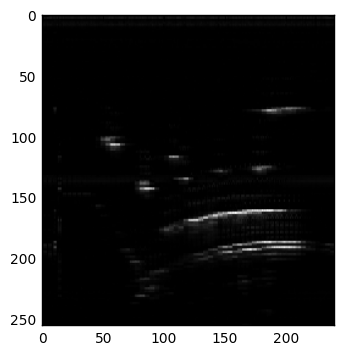Testing DICOMizing Croaker acquisitions
raw_data/rebuild.py
import sys
import numpy as np
from operator import itemgetter, attrgetter
import Image
from math import *
import math
import matplotlib.pyplot as plt
from mpl_toolkits.mplot3d import Axes3D
import matplotlib.mlab as mlab
# DICOM
import dicom, dicom.UID
from dicom.dataset import Dataset, FileDataset
import datetime, time
Tableau = []
with open("raw_data/20161217-222737-total.csv", 'r') as echOpenLog:
for line in echOpenLog:
if(line.startswith("#")):
#print "commentaire"
ikl = 0
else:
line = line.strip().split(';')
Tableau.append(line)
Tableau = np.asarray(Tableau, dtype=np.float32)
NbOfLines,PointsPerLine = (np.shape(Tableau))
plt.imshow((np.transpose(Tableau) ), cmap="gray")
plt.show()
Raw = Tableau*65535/np.amax(Tableau)

maxAngle = 30.0
ImagePoints = Tableau
step = 2.0*maxAngle/(NbOfLines+1)
size = (NbOfLines,PointsPerLine)
X=np.zeros(shape=(size[0],size[1]))
Y=np.zeros(shape=(size[0],size[1]))
for i in range(size[0]):
for j in range(size[1]):
X[i][j] = j*math.cos(math.radians(step*i-maxAngle))
Y[i][j] = (size[1]+1)/2.0+j*math.sin(math.radians(step*(i)-maxAngle)) # same
print int(size[1]*math.cos(math.radians(maxAngle)))
MaxDepth = int(size[1]*math.cos(math.radians(30)))
sizeSC = (size[1],size[1])
ScanConverted=np.zeros(shape=(size[1],size[1]))
ScanConverted = ScanConverted + 40
pix = np.zeros(shape=(size[1],size[1]))
print sizeSC
for i in range(size[1]):
for j in range(size[1]):
#value = np.amax(ImagePoints)
pix[i,j] = 0
for i in range(size[1]):
if (i<MaxDepth):
if (i>=0 & i<=(size[1])):
sweep = int(i*(254/2)/220)
for j in range((size[1]/2-sweep),(size[1]/2+sweep)):
D = (X-i)**2 + (Y-j)**2
resul = np.unravel_index(D.argmin(), D.shape)
# here is a basic NN, not even a 2-tap
ScanConverted[i][j] = ImagePoints[resul[0]][resul[1]]
#print value
value = ScanConverted[i][j]
pix[j,i] = value
if not(i%50):print i
else:
for j in range(size[1]):
if ( (i**2) + (j-(size[1]/2))**2 ) < ((size[1])**2 - 1):
D = (X-i)**2 + (Y-j)**2
resul = np.unravel_index(D.argmin(), D.shape)
# here is a basic NN, not even a 2-tap
ScanConverted[i][j] = ImagePoints[resul[0]][resul[1]]
value = ScanConverted[i][j]
#print value
pix[j,i] = value
if not(i%50):print i
pix = np.asarray(pix, dtype=np.float32)
pix = pix*65535/np.amax(pix)
plt.imshow((np.transpose(pix) ), cmap="gray")
plt.show()
220
(255, 255)
0
50
100
150
200
250

x = range(sizeSC[0])
y = range(sizeSC[1])
hf = plt.figure()
ha = hf.add_subplot(111, projection='3d')
X, Y = np.meshgrid(x, y) # `plot_surface` expects `x` and `y` data to be 2D
ha.plot_surface(X, Y, np.sqrt(pix))
plt.show()

def write_dicom(pixel_array,filename):
"""
INPUTS:
pixel_array: 2D numpy ndarray. If pixel_array is larger than 2D, errors.
filename: string name for the output file.
"""
## This code block was taken from the output of a MATLAB secondary
## capture.
file_meta = Dataset()
file_meta.MediaStorageSOPClassUID = 'Ultrasound_Image_Storage'
file_meta.MediaStorageSOPInstanceUID = '1.2.840.10008.5.1.4.1.1.6.1' # Ultrasound
file_meta.ImplementationClassUID = '1.3.6.1.4.1.9590.100.1.0.100.4.0'
ds = FileDataset(filename, {},file_meta = file_meta,preamble="\0"*128)
ds.Modality = 'WSD' # Workstation
ds.ContentDate = str(datetime.date.today()).replace('-','')
ds.ContentTime = str(time.time()) #milliseconds since the epoch
#ds.StudyInstanceUID = '1.3.6.1.4.1.9590.100.1.1.12431397741236017523427128747280487209311'
#ds.SeriesInstanceUID = '1.3.6.1.4.1.9590.100.1.1.3692311180110610034034218591726431436492'
#ds.SOPInstanceUID = '1.3.6.1.4.1.9590.100.1.1.1111656844110176690217683857207368737803'
ds.SOPClassUID = 'Ultrasound_Image_Storage'
ds.SecondaryCaptureDeviceManufctur = 'Croaker - https://github.com/kelu124/echomods/blob/master/croaker/data/20161217/20161217-TestingArduinoAndPhantom.md'
## These are the necessary imaging components of the FileDataset object.
ds.SamplesPerPixel = 1
ds.PhotometricInterpretation = "MONOCHROME2"
ds.PixelRepresentation = 0
ds.HighBit = 15
ds.BitsStored = 16
# spatial resolution: see http://dicom.nema.org/medical/dicom/2014c/output/chtml/part03/sect_10.7.html#sect_10.7.1.3
ds.PixelSpacing = '\\0.44\\0.44' # mm/pixel
# F acq = 1.715MHz see https://github.com/kelu124/bomanz/blob/master/ADC08200/20170430-ADC08200-FirstAcqs.ipynb
# then with v = 1500 then 1 sample is (1500/2)*1.715*10^6 ( 437,317784257µm by pixel )
ds.BitsAllocated = 16
ds.SmallestImagePixelValue = '\\x00\\x00'
ds.LargestImagePixelValue = '\\xff\\xff'
# Creating the image itself
pixel_array = np.array(np.transpose(pixel_array))
ds.Columns = pixel_array.shape[1]
ds.Rows = pixel_array.shape[0]
if pixel_array.dtype != np.uint16:
pixel_array = pixel_array.astype(np.uint16)
ds.PixelData = pixel_array.tostring()
ds.save_as(filename)
return filename
write_dicom(pix,"20170502-DICOMizingCroakerData.dcm")
'20170502-DICOMizingCroakerData.dcm'
print repr('\\x0.44\\x0.44')
'\\x0.44\\x0.44'